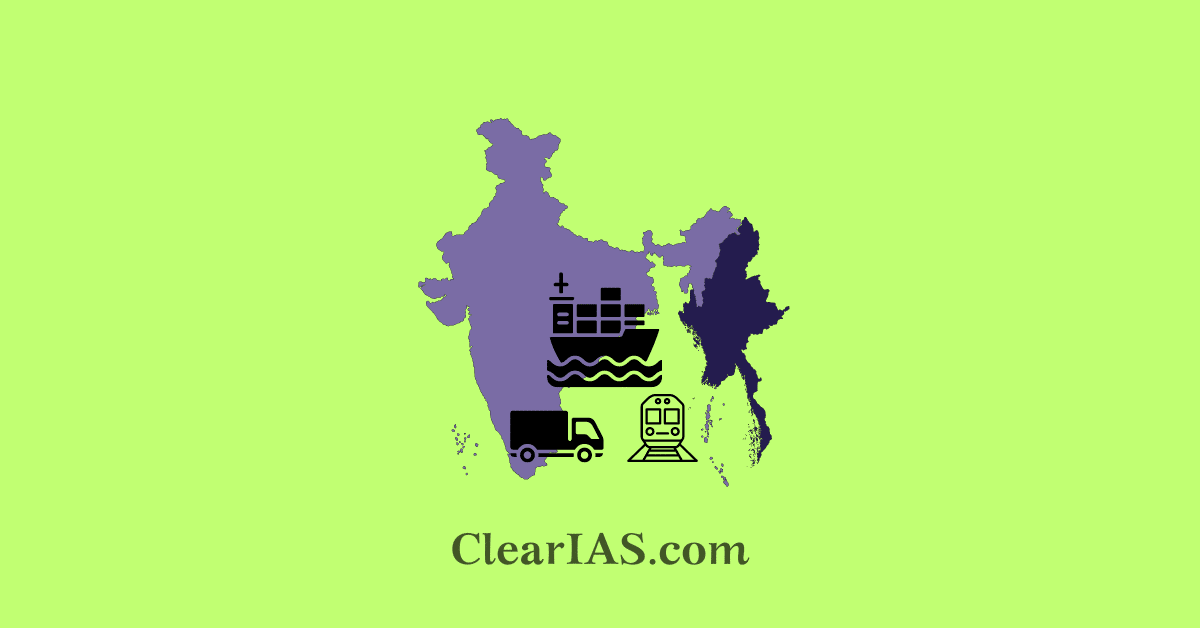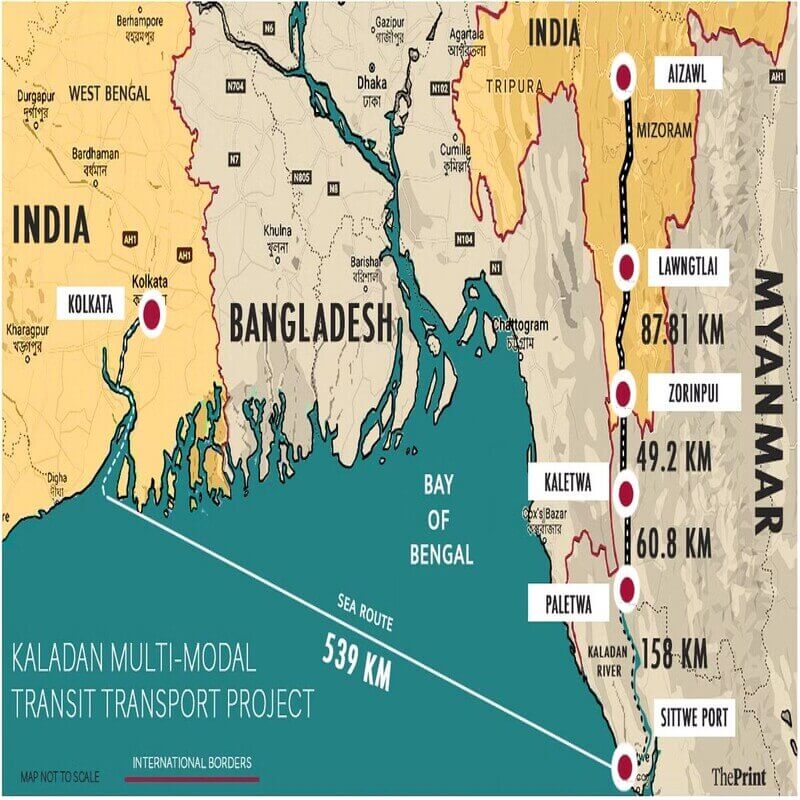
Kaladan Multi-Modal Transit Project was jointly identified by India and Myanmar. The primary aim was to create an alternative route to connect northeast and mainland India. The ambitious project has greater geopolitical implications as well. Read here to understand in detail the significance of the project.
Recently, the inaugural vessel was flagged off from Syama Prasad Mookerjee Port in Kolkata to officially kick-start the operation of Sittwe Port in Myanmar which is a part of Kaladan Multimodal Transit Transport Project (KMTTP).
The successful operation of the project is vital and significant to India’s commerce and connectivity, especially concerning the northeastern region.
The project was envisioned to provide an alternate access route to the North-Eastern region of India and contribute towards the region’s economic development.
Being a key connectivity project, it will promote economic, commercial, and strategic links between India and Myanmar.
Kaladan Multi-modal Transit Project
The Kaladan Multi Modal Transit Transport Project was jointly identified by India and Myanmar to create a multi-modal mode of transport for the shipment of cargo from the eastern ports of India to Myanmar as well as to the North-Eastern part of India through Myanmar.
- Ministry of External Affairs (MEA), Govt. of India entered into a Framework Agreement with the Govt. of Myanmar in April 2008 to facilitate implementation of the project.
This project connects Sittwe Port in Myanmar to the India-Myanmar border and is expected to contribute to the economic development of the North-Eastern States of India, by opening up the sea route for the products.
- It also provides a strategic link to the North-East, thereby reducing pressure on the Siliguri Corridor.
- In the absence of an alternate route, the development of this project not only serves the economic, commercial, and strategic interests of India, but also contributes to the development of Myanmar, and its economic integration with India.
- Since the project is of political and strategic significance, it was decided to execute it through India’s grant assistance to Myanmar.
Inland Waterways Authority of India (IWAI) is the Project Development Consultant (PDC) appointed by the MEA in 2009 for the implementation of the Port & IWT components.
The routes

The project has several segments combining multi-modes of transport:
- Kolkata-Sittwe shipping route – 539 km (335 mi) from the seaport of Kolkata in India to the Sittwe seaport in Myanmar via the Bay of Bengal.
- Sittwe seaport to Paletwa inland jetty river boat route – 158 km (98 mi) from Sittwe seaport to Inland Water Terminal (IWT) and hydropower project at Paletwa jetty via Kaladan river in Myanmar.
- Paletwa inland jetty to Zorinpui road route in Myanmar – 62 km (39 mi) 4 lane road route from IWT Paletwa to Zochawchhuah(India)-Zorinpui (Myanmar) at Indo-Myanmar border in Myanmar.
- Zorinpui to Aizawl Road route in India – 110 km (68 mi) from the Indo-Myanmar border at Zorinpui to Aizawl.
- From Aizawl, it connects to Aizawl-Saiha National Highway at Lawngtlai in Mizoram, India by road on National Highway 54 (NH-54), which then continues further to Dabaka in Assam via NH-54 which in turn is part of the larger East-West Corridor connecting North East India with the rest of India.
A complimentary railway route is also in works to connect Sittwe to Zochawchhuah (Zorinpui)–Sairang railway in India.
Significance of the Kaladan Multi-Modal transit project
India has long sought a way to get supplies to the landlocked northeastern States through Bangladesh.
- The sole route from the rest of India to this region at the moment is a fairly tortuous one through a small section of Indian territory in West Bengal known as the Chicken’s Neck that is tucked between Bhutan and Bangladesh.
- With the new Sittwe route, traveling from Kolkata to Mizoram and beyond would be cheaper and shorter in both cost and mileage.
- The project will boost the economic development of the northeastern states with the advent of several industrial clusters in the region.
It is anticipated that it will improve India and Myanmar’s economic, commercial, and strategic connections as well as open up maritime channels and encourage economic growth in the Northeastern states.
- This multimodal transit route will serve the strategic needs of the nation by providing easy accessibility to northeast and southeast Asia as well.
- It’s a major step towards the fulfillment of Act East policy and regional integration as well.
- As a result, the industrial development and harnessing of tourism potential will help in socio-economic development and employment generation
- This project will further boost India’s trade with South East Region.
- The project also serves as a counter to Chinese expansion in the region as well.
Concerns
The largely ambitious and costly project comes with its share of concerns-
- The full operation of Chittagong port in Bangladesh might lead to lesser shipments to Sittwe port than expected since Chittagong is better connected with India.
- The lack of an environmental impact study is quite concerning, particularly in light of river dredging at the Kaladan River mouth for the barges.
- Any dispute between the nations might lead to tensions at the port, which would hinder the movement of products; or if an issue develops in North-East India or Myanmar, such as the Rohingya crisis, it would have an impact on both nations, notably India, which paid for the project.
- Both nations are concerned about the project Kalandan’s potential to enhance the likelihood of the illegal trafficking of narcotics, weapons, and other sources.
Initiatives for southeast connectivity
Kaladan multimodal transit project was one the major projects designed to promote connectivity in the region. There are other initiatives as well-
- Protocol on Inland Water Transit and Trade between India and Bangladesh.
- India-Myanmar-Thailand Trilateral Highway (IMT) connecting Moreh in India with Mae Sot in Thailand via Myanmar.
- India-Japan Act East Forum (AEF) aims to promote connectivity within NER and between NER and Southeast Asia.
- Bangladesh-Bhutan-India-Nepal Motor Vehicles Agreement
- Paletwa–Cikha–India Highway (Chin state of Myanmar)
- Sabang strategic port development, India-Indonesia project
Way forward
Since 1991, when the Look East policy was introduced to develop political contacts with the South-Eastern countries of Myanmar, Thailand, Cambodia, Indonesia, Singapore, Vietnam, Laos, Philippines, and Brunei Darussalam, the region has been significant for India.
Since 2014, the government has been working towards strengthening India’s relations with South-East Asian countries as part of the Act East Policy which was rechristened from the Look East Policy.
The Kaladan multi-modal project has many facets. Roads and canals working together will shorten travel times, lower transportation costs, and increase trade between India and other nations.
The project’s development of the North East, where commodities from the region may be carried directly by sea rather than by road from other ports in India, holds the greatest promise.
Given that Myanmar is the only country in Southeast Asia with which India shares borders, Myanmar is crucial from a strategic perspective. It serves as India’s geographical connection to other South-East Asian nations.
The bilateral security patrols demonstrate India’s commitment to the security of the Sittwe port, which affects the prosperity and stability of North-East India.
Thus, the Kaladan project’s operationalization will bring India one step closer to attaining the Act East Policy’s main goal.
Read: India-Myanmar Relations; Free Movement Regime
-Article written by Swathi Satish






Leave a Reply